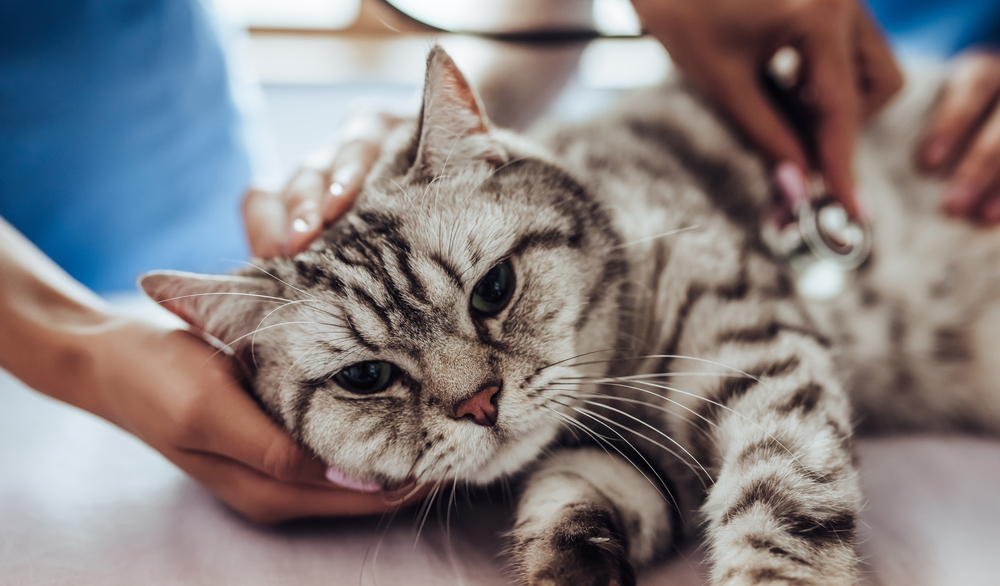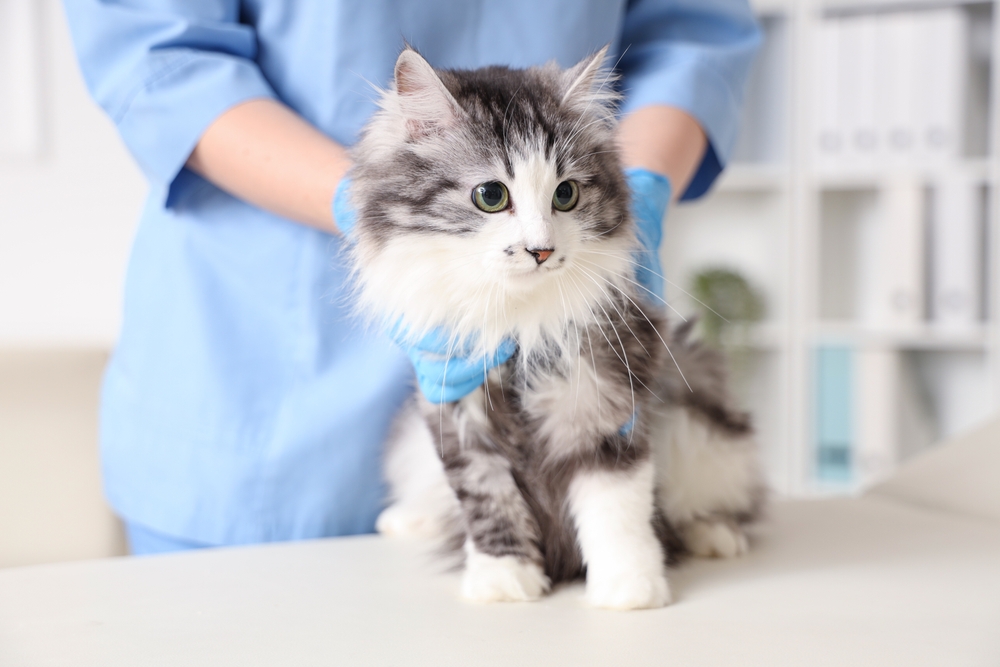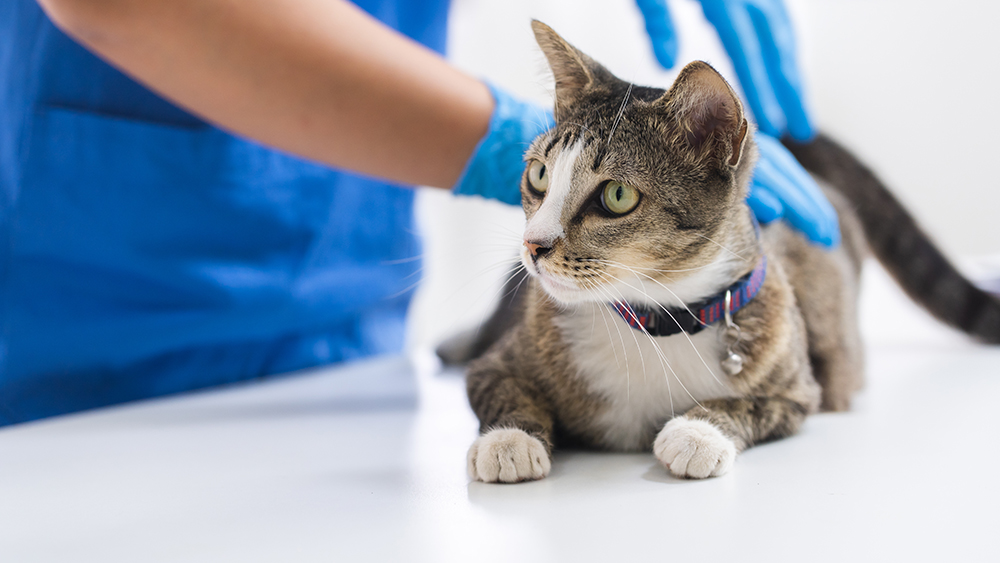If you’re interested in multiple myeloma, your cat may have been recently diagnosed with this rare disease. If this is the case, we’re very sorry and understand you’ll want to know everything about the condition and what to expect moving forward.
Multiple myeloma is a cancerous disease, meaning that it’s caused by the uncontrolled growth of the cat’s own cells. As these cells proliferate, they cause harm to the vital body systems that keep your cat alive.

What Is Multiple Myeloma?
Multiple myeloma is a rare cancer originating from a type of white blood cell in the bone marrow. In healthy cats, the bone marrow contains stem cells that reproduce and mature into blood cells such as platelets, red blood cells, and white blood cells. The white cells fight infection, platelets help with blood clotting, and red cells are the carrier cells for transporting oxygen around the body.
One type of white blood cell is the plasma cell, which is responsible for the production of antibodies. Cancer of this cell line within the bone marrow causes multiple myeloma. However, if plasma cells cause cancer outside the bone marrow, it is called a plasmacytoma. However, multiple myeloma can spread from the bone marrow to other organs.
The uncontrolled production of plasma cells results in excessive amounts of antibodies in the blood. Cancerous cells and the resulting antibodies can cause problems all around the body. Although cancer can originate in any bone, most arise in the spinal vertebrae.

What Are the Signs of Multiple Myeloma?
Multiple myeloma typically occurs in cats over the age of 7 and appears to have similar rates in male and female cats. Signs of multiple myeloma are generalized to start with and worsen with time. Specific signs can be related to organs being impacted by the cancer. Generally, the first non-specific signs of the problem are:
Signs:
- Lethargy
- Anorexia
- Weight loss
- Limping
- Pain
There are, however, several complications of multiple myeloma that can result in more severe signs.
These complications include:
- Hyperviscosity syndrome: Too many antibodies in the blood cause it to become physically thickened. Signs of hyperviscosity syndrome can be neurological or related to blood clotting or heart failure. Seizures, blindness, and respiratory distress are common signs of this syndrome in cats.
- Pathological fractures: Bones with tumor involvement may lose calcium and resorb, resulting in areas of weakness. Weakened bone is more prone to fractures, known as pathological fractures, as they occur without the trauma usually needed to break a bone.
- High blood calcium: This is common in cats with multiple myeloma due to bone resorption and cancer interfering with parathyroid gland function. It can lead to kidney damage and weakness.
- Kidney disease: Aside from the excess calcium, the abnormal antibody protein level can damage the kidneys. Cats with kidney problems will drink and urinate more to compensate and, in more severe cases, can develop vomiting, diarrhea, nausea, and poor appetite.
- Blood clotting disorders: Platelets may also be impacted by the cancer, causing a reduction in blood clotting ability. Signs can include bleeding internally into the eyes, abnormal bruising, or visible bleeding. There can be blood in the digestive tract, causing black, tarry stools.
- Metastasis: The cancer cells can spread from the bone marrow to other organs and impact their function, including the kidneys, liver, and spleen. This is known as metastasis.
- Weak immune system: The immune system is weakened as the cancerous cells don’t function correctly, and the cancer may also crowd out sites needed for normal white cell production. Cats with multiple myeloma are prone to infections.
- Anemia: In some cases, red blood cell production may not be adequate, leading to anemia.
- Spinal cord compression: The tumor or weakened bones pressing on the spinal cord can lead to signs like weakness, wobbly gait, abnormal reflexes, and even paralysis.


What Are the Causes of Multiple Myeloma?
There has been no conclusive evidence about what causes multiple myeloma in cats. However, one study reports the occurrence of this rare condition in siblings, suggesting a possible genetic predisposition. This theory needs to be explored further but is backed up by findings in mice and humans.
Unlike other white blood cell cancers, viruses like Feline Leukemia Virus, Feline Immunodeficiency Virus, and Feline Infectious Peritonitis do not appear to be implicated in multiple myeloma.
Finally, the environment can be important. Exposure to carcinogens like exhaust fumes and other chemicals can increase the risk of cancer. One study showed people in certain professions had an increased risk of multiple myeloma.
Diagnosing Multiple Myeloma in Your Cat
If your cat shows signs of being unwell, the first step is a veterinary consultation and examination. Your vet will consider your cat’s history and the signs they’re showing to determine the next steps.
Since multiple myeloma is very rare and the initial signs are quite general, this potential diagnosis may not be the first on your vet’s list. There is a saying in medicine, “If you hear hoofbeats, think horses, not zebras,” which means that certain illnesses are more common than others.

Multiple myeloma can be diagnosed when two of the following are found:
- Moth-eaten bone lesions on X-rays
- Bone marrow biopsy finds cancerous cells or an abnormally high portion of plasma cells
- A specific protein related to antibodies in the urine (Bence-Jones proteinuria)
- High levels of a specific protein related to antibodies in the blood (paraproteinemia)
- Cancerous plasma cells in organs
Extensive testing is needed to reach this definitive diagnosis. Initial testing at your general practice veterinarian may include:
- Hematology: This tests red and white cell and platelet counts. In cases of multiple myeloma, this may show anemia, low platelet count, or low white cell count.
- Serum biochemistry: This measures blood protein and calcium levels, which are likely to be high in cats with multiple myeloma. It can also assess kidney function and help rule out other health problems.
- Urine testing: Basic urine testing can rule out a secondary urinary tract infection and help assess hydration and kidney function. More specific urine tests are sent to a lab to look for Bence-Jones proteinuria.
- X-rays: They must be detailed and taken of the whole body to look for bone lesions.
- Ultrasound: It can help detect areas of organ enlargement, potentially indicating metastasis.
- Bone marrow biopsy: It’s usually performed on areas of bone lesions. Almost all cases of multiple myeloma will show abnormal plasma cells with this test.
- Serum protein electrophoresis: This is a laboratory test designed for paraproteinemia.
The results of the tests may not only diagnose your cat but also help your vet to determine their prognosis. According to one study of nine cats, the following was associated with a poor prognosis in cats with multiple myeloma:
- Low blood calcium
- Pathological fractures
- Anemia
- Bence-Jones proteinuria
- Kidney damage

How Do I Care for a Cat With Multiple Myeloma
Cats with multiple myeloma need veterinary care and excellent nursing care at home. At the vet, your cat may need a fluid drip to support their kidneys and rehydrate them. Fluids also help treat hyperviscosity syndrome. On diagnosis, vets will start long-term antibiotics to protect your cat against infection. They will also provide symptomatic treatment on a case-by-case basis. Many cats need pain relief, while others need more specific medication.
You will also have the option to pursue advanced cancer treatment for your cat. It’s fine not to do this based on your circumstances or beliefs. However, it could extend your cat’s life and improve their quality of life. Without it, euthanasia may need to occur sooner rather than later.
Advanced cancer treatments are generally prescribed by a veterinary oncologist. In some cases, surgery can be recommended for damage control. These specialists can develop a plan for surgery, radiation, or chemotherapy, as well as extensive follow-ups, to help your cat. Your vet will want to monitor for side effects related to treatment as well as your cat’s response to treatment. For example, a reduction in blood protein after treatment is a good sign.
Good nursing care at home is essential. While not all these interventions may be necessary for every cat with multiple myeloma, we recommend speaking to your vet about the following:
- Keep your cat clean and reduce their risk of infection: Cleaning up urine and feces, keeping your cat’s environment hygienic, and avoiding raw food can help. You should also pay attention to dental hygiene since bacteria can build up in the mouth.
- Optimizing their nutrition and hydration: Choosing nutrient-dense wet foods can help keep weight on your cat and hydrate them. Offering water several times a day is a good idea to encourage your cat to drink. Ask your vet if any water additives are suitable to improve your cat’s hydration.
- Keeping your cat rested during their initial treatments: This can help reduce the risk of pathologic fractures and improve their comfort with bone lesions that cause pain.
- Helping your cat with urination: If they cannot empty their bladder on their own, you may need to help them.
💛 😺 Speak To a Vet Online From the Comfort of Your Couch!

If you need to speak with a vet but can’t get to one, head over to PangoVet. It’s an online service where you can talk to a vet online and get the personalized advice you need for your pet — all at an affordable price!

Frequently Asked Questions (FAQ)
How Long Can a Cat Live With Multiple Myeloma?
One study showed that out of eight cats receiving chemotherapy for multiple myeloma, four had a complete response, and one had a partial response. Those who responded survived for between 4 and 24 months. The average survival time with treatment is around 42–281 days. Cats that don’t receive advanced treatment or do not respond to treatment will have a shorter lifespan.
Is Bone Marrow Cancer Painful in Cats?
Bone marrow cancers like multiple myeloma can be painful, especially if they cause the bone to be eaten away or pathological fractures. These cats often need one or more pain relief medications to remain comfortable. Don’t be afraid to discuss this with your vet if your cat is in pain. In addition to the pain, these cancers can cause changes that make your cat feel generally lethargic or nauseous.

Conclusion
Multiple myeloma is a rare form of bone cancer in cats. While cats with multiple myeloma will eventually succumb to their condition, a period of remission is possible. Unfortunately, some cats don’t respond despite the best treatment, and many have highly aggressive forms of multiple myeloma. Your vet can look for signs that might indicate a poor prognosis for your cat.
When your cat is diagnosed with multiple myeloma the most important thing is their comfort and quality of life. That is why you should pamper your cat with multiple myeloma, monitor for any signs of pain or discomfort, and follow your vet’s advice.
Featured Image Credit: Kginger, Shutterstock

